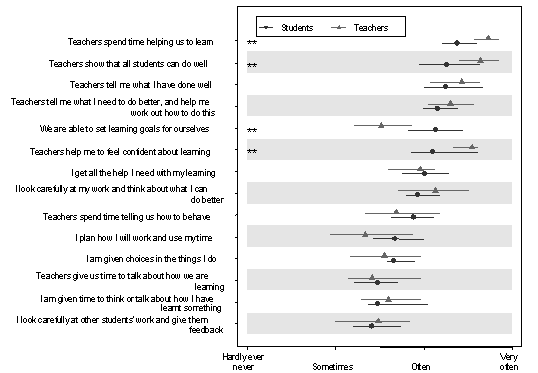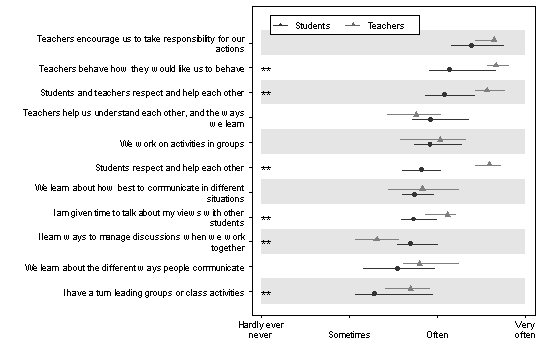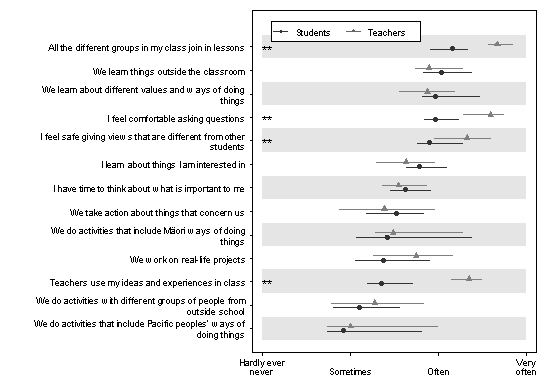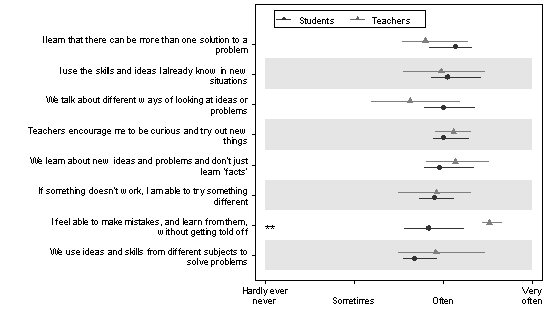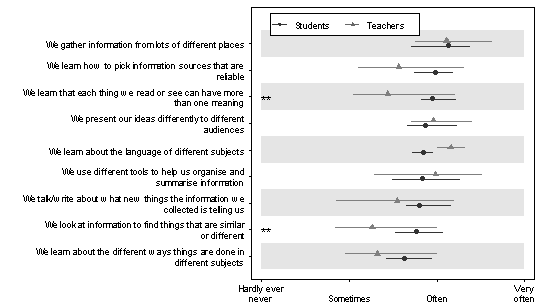Exploring pedagogy and opportunities to learn
What is “authentic” learning and how do we do it?
The OECD developers of the international key competencies model note that their definition of competence places:
…the complex demands and challenges that individuals encounter in the context of work and in everyday life at the forefront of the concept… (Rychen & Salganik, 2003, p. 43)
Hipkins (2005) suggests that this statement indicates that the key competencies are intended to be developed in contexts that are challenging, have personal relevance to students, and require them to actively engage with problems. This implies some key shifts in practice, for example, an increasing use of student-centred practices to source contexts that are authentic for learners, and an emphasis on the idea of ‘using’ rather than ‘covering’ curriculum content. 1
When we visited the schools, and as part of the surveys, we looked for examples of how schools and teachers were framing and creating these challenging, complex, and real learning opportunities. We called this “authentic learning” and we looked for learning situations which:
- enabled students to take action on real projects of concern to themselves or society
- gave opportunities for student choice
- gave opportunities for challenge or risk taking
- were fun, relevant, and engaging
- related to students’ needs and level (were differentiated).
We found that staff had varying views as to what constituted a rich or authentic learning situation. Most staff cited inquiry or integrated projects, school productions and camps, and other learning experiences outside the classroom as situations that were likely to provide students with rich experiences that would enable them to develop the key competencies.
In general, teachers considered it was easiest for students to recognise the key competencies in the context of “learning by doing”. This perception was confirmed during the student focus groups. Students were most likely to talk about how they had demonstrated the key competencies in the context of ‘big’ learning events such as stage performances or school camps, in-depth inquiry projects, and teamwork such as school sports. Students and teachers also discussed the three more familiar and socially-orientated key competencies ( Managing self, Relating to others, Participating and contributing) in relation to everyday interactions in the classroom, the playground, and at home.
The authentic learning situations described by teachers included visits to local museums or inquiry projects and enabled students to ‘learn about’ or ‘learn in’ real contexts outside school. Many of these situations were created ‘for’ but not ‘by’ students.
An alternative view of authentic learning was offered by some staff. This view aligned with the ideas about action competence 2 that underpin models of environmental education (Ministry of Education, 1999a), the Health and Physical Education curriculum (Ministry of Education, 1999b), and the likely intent of Rychen and Salganik (2003). These staff considered that authentic learning involved students working on projects to research, design, plan, and create solutions to real-life problems. These teachers reframed the experiences listed above or created new ways of giving students these opportunities. Examples of this included:
- students planning healthy food menus, budgeting, or designing games for a school camp
- students designing and performing a school production and organising marketing for this production
- students exploring new options for their overcrowded school bus service, and working with the local council to develop solutions
- junior students researching local playgrounds and presenting a submission on improvements to the local council
- students writing, designing, and making books to be transported to an overseas school that lacked resources
- students engaging in science fair projects
- students engaging in environmental projects such as designing areas of the school grounds to make them more appealing.
This reframing necessitates a shift in teachers’ roles. Although scaffolding is important, these situations require teachers to be less in the driving seat in regard to decision making.
Integrated approaches to learning
All of the schools were experimenting with curriculum integration models. There appeared to be two main drivers for this. On a pragmatic level, integration was a response to curriculum overcrowding. To deal with the number of learning areas they had to cover, and to do justice to the National Administration Guidelines (NAGs), many schools had evolved an approach that ensured students had strong foundations in literacy and numeracy. This was achieved by offering standalone literacy and numeracy in the morning and ‘integrating’ other subjects in the afternoon (such as science, social studies, arts, and technology).
Another driver for curriculum integration was philosophical. There was a desire to provide rich and authentic learning opportunities and co-construction of the curriculum as suggested by James Beane (1997), a researcher and programme developer widely recognised as one of the architects of the current curriculum integration movement.
The models used at the schools can be seen to form a continuum of curriculum integration, as shown in Table 2. At one end is a traditional teaching programme. At the other end is the student-driven exploration of problems pertinent to society as suggested by Beane (1997).
Table 2: A continuum of curriculum integration
|
| Type of integration
|
|---|
| Aspect
| Traditional (no integration)
| Topic connection (partial integration)
| Full integration
|
|---|
| Place of curriculum
| Separate curriculum areas
| Partial integration of content or curriculum areas (e.g., literacy and numeracy activities connected to social studies science, drama, or sports events)
| Integration of those aspects of subjects that are necessary to the learning context
|
| Programme driver
| Coverage-driven programmes (contexts stem from the curriculum)
| Mix of coverage- and context-driven programmes (contexts stem from the curriculum and teacher interests)
| Context-driven programmes (contexts are problems relevant to students and society)
|
| Opportunities for student-choice
| No student choice
| Limited student choice
| Issues decided by co-construction (many opportunities for student choice)
|
Examples of all three types of integration co-existed in schools. Approaches that fell into the ‘topic-connection’ category were most common. Examples included students writing reports about their experiences in other curriculum areas rather than utilising the opportunities for literacy instruction that might arise within the learning context. ‘Topic connection’ often occurred when students participated in a drama production or school camp and then later engaged in literacy, visual art, or drama work that documented their experiences. Students did not perceive these opportunities to be co-constructed—rather, they were organised for them by teachers.
This research suggests there is potential for these experiences to be reframed so that they offer more opportunities for co-construction and fuller integration. This reframing would increase the potential to provide students with ownership over their learning and opportunities to develop and demonstrate the key competencies. For example, students could explore their peers’ concerns about bullying through a survey, then design a way of sharing information about strategies to deal with bullying such as writing, advertising, and performing a drama production, or the development of a peer mediation programme.
Inquiry models
Inquiry learning was also seen as a vehicle to provide authenticity. Most schools were using inquiry-learning models within an integrated framework. Schools varied as to how inquiry learning was conceptualised. In most cases an inquiry approach was described as a tool to teach students a research process, that is to “ learn about doing” and in some cases by “ learning in” a particular environment. Visiting the school library, a local museum, or a website to gather information was a common example of this. In some cases inquiry processes were being used as a tool to support students to develop action competence as they “ learnt by doing”. As for approaches to integrated learning, it appears that the potential for inquiry approaches to provide rich opportunities for students to develop and demonstrate the key competencies could be further tapped.
Exploring the survey data related to opportunities for authentic learning
This section of the report examines some of the combined student and teacher data from the survey of classroom practices relating to the key competencies. This data is explored to ascertain current practice in the schools, including the frequency of practices connected to the ideas about authentic learning described above.
Overall, a similar pattern emerges across each key competency, with some practices being rated by both students and teachers from all schools as occurring more frequently than others. 3 Across schools students show fairly similar responses and teachers display more variability. In some cases teacher and student perceptions as to the frequency of practices are similar. In other cases (marked with ** on each graph) there are significant differences between teacher and student views.
Managing self
Figure 2 shows teacher and student views on the frequency of practices connected to the key competency: Managing self. This data shows that teachers’ priorities were centred around creating a positive classroom climate in which high expectations and constructive feedback were the norm. Teachers were more likely than students to think that this environment was in place. Practices that gave students autonomy over their learning or which involved explicit teaching about meta-cognition were less frequent.
Figure 2: Frequency of practices linked to Managing self
** indicates a significant difference of p < 10 -5
Relating to others
Figure 3 shows teacher and student views on the frequency of practices connected to the key competency: Relating to others. Again, teachers’ priorities centred around creating a climate in which positive behaviours were modelled and encouraged. This data shows that the explicit teaching of group work or communication strategies were less of a focus. There were more differences between student and teacher views on the frequency of practices connected to Relating to others than for the other key competencies. Teachers tended to view these practices as happening more often than students.
Figure 3: Frequency of practices linked to Relating to others
** indicates a significant difference of p < 10 -5
Participating and contributing
Figure 4 shows teacher and student views on the frequency of practices connected to the key competency: Participating and contributing. We explored two main aspects of Participating and contributing: within the classroom; and making connections outside the school environment. This data showed that participation within the classroom was a priority. Practices that related to participation in learning situations in a broader range of social and cultural contexts were less frequent, and overall were the lowest rated practices from all of the five key competencies. The data showed a greater variability between schools for this key competency compared to the others, with some schools being more likely than others to include contexts that enabled students to take action on issues of concern to themselves or that incorporated Māori or Pacific ways of doing things. Participating in a broad range of contexts outside of the classroom, and taking action on issues of concern are practices that are linked to the idea of authentic learning discussed earlier. This data suggests that students may not have frequent access to these opportunities.
Figure 4: Frequency of practices linked to Participating and contributing
** indicates a significant difference of p < 10 -5
Thinking
Figure 5 shows teacher and student views on the frequency of practices connected to the key competency: Thinking. Overall teachers and students considered practices relating to this key competency occurred relatively frequently.
Figure 5: Frequency of practices linked to Thinking
** indicates a significant difference of p < 10 -5
Using language, symbols, and texts
Figure 6 shows teacher and student views on the frequency of practices connected to the key competency: Using language, symbols, and texts (ULST). Less complex practices, such as gathering information, tended to be rated as happening the most frequently, and more complex practices, such as understanding subject conventions, less frequently. Teachers rated the more complex practices as occurring less frequently than students. This may well reflect teachers’ more complex understanding about what these practices entail. Teachers showed greater variability between schools than students. It is possible that this variation reflects varied interpretations of the meaning of ULST, and/or teachers’ level of comfort with practices relating to ULST.
Figure 6: Frequency of practices linked to Using language, symbols, and texts
Exploring patterns in the survey data
As well as asking teachers to rate how often each practice occurred in their classrooms we also asked them to indicate, using a 5-point scale, how important they considered each practice to be. Overall, teachers considered most practices to be ‘very important’ or ‘important’, and those practices that were rated as the most important tended also to be rated as happening frequently. Table 3 shows the 15 items teachers most often rated as ‘very important’.
Table 3: Top 15 teacher items in order of importance
| Survey item
| KC
| Rating
|
|---|
| Teachers encourage students to take responsibility for their actions
| RO
|
Most
Important
|
| Teachers model the behaviours, skills, and attitudes they would like students to develop
| RO
|
| Students are encouraged to respect and help each other
| RO
|
| Students are supported to feel safe asking questions
| PC
|
| Teachers spend time helping students to learn
| MS
|
| All student groups are actively supported to join in lessons
| PC
|
| Students and teachers are encouraged to respect and help each other
| RO
|
| Teachers have high expectations for all students
| MS
|
| Teachers help students feel confident about learning
| MS
|
| Students have the opportunity to make mistakes, and learn from them without penalty
| T
|
| Teachers give students feedback about areas for improvement, and assist students to work out their next learning steps
| MS
|
| Students are supported to feel safe when giving views that are different from other students
| PC
|
| Teachers give students feedback about their strengths
| MS
|
| Students’ existing knowledge and experiences are used in teaching
| PC
|
| Students have the opportunity to identify and discuss new ideas and problems, and don’t just learn “facts”
| T
|
* This table shows each practice using the language from the teacher survey. In some cases the wording used in the student survey was slightly different.
A thematic clustering of items is evident in this list. Most of the top 15 items are connected to the three most familiar and socially-orientated key competencies, that is, Managing self, Relating to others, and Participating and contributing. Furthermore, the Participating and contributing items relate to aspects of this key competency that are demonstrated within classroom interactions. This clustering shows that teachers’ priorities were centred around creating safe learning environments in which students felt comfortable about learning and expressing themselves, and in which students were offered constructive feedback about their learning. It appears that teachers’ priorities were on creating better conditions for learning rather than “better learners”.
Table 4 shows the 15 items teachers rated as being the least important.
Table 4: Lowest 15 teacher items in order of importance
| Survey item
| KC
| Rating
|
|---|
| Teachers support students to take action on issues of concern to themselves
| PC
| Least important
|
| Learning activities enable students to participate in a range of social and cultural settings
| PC
|
| Students set their own learning goals
| MS
|
| Knowledge and texts are presented to students as having different interpretations rather than as given “facts”
| ULST
|
| Students are taught how to analyse different types of information to look for patterns and trends
| ULST
|
| Students are given time to explore and clarify their own values
| PC
|
| Students are given choices in learning activities or contexts
| MS
|
| Classroom contexts include Māori points of view and ways of doing things
| PC
|
| Students are taught ways to manage group dynamics
| RO
|
| Students are supported to assess their peers’ work and give feedback
| MS
|
| Students take part in discussions about meta-cognition and how they learn
| MS
|
| Students have the opportunity to learn about the conventions of different subjects
| ULST
|
| Students plan how they will work, and organise their time
| MS
|
| Classroom contexts include Pacific peoples’ points of view and ways of doing things
| PC
|
| Teachers spend time telling students how to behave
| MS
|
Different patterns are evident in the items in Table 4, compared with Table 3. The items that were rated as less important (and usually as occurring less frequently) are pedagogies that are more unfamiliar, and therefore likely to be more challenging, than the practices in Table 3. 4 The practices that fall into this category are the aspects of:
- Managing self that relate to student autonomy over learning and meta-cognition
- Participating and contributing that relate to action competence and learning in environments that are socially and culturally diverse
- ULST that relate to understanding about different subject conventions and critical literacy.
This data gives an indication of the aspects of the key competencies that teachers were finding more difficult to incorporate into their practice, and the newer and more complex territories that an exploration of the key competencies could be leading schools towards.
Published on: 19 Sep 2007
Return to top

